Guiding the Way Forward
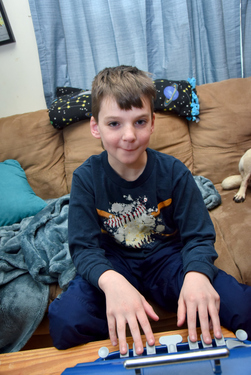
Eight-year-old Derek Beck explains the keys that you find on a Brailler and how it works.
“When you’re making a letter, you have dots on the keys, and you have to press it at the same time,” he says.
Derek has been studying Braille for about a year and a half and has made great strides in mastering it. His instructor, Jennie Oulton, a teacher for students with visual impairments (TVI), couldn’t be more impressed with his progress.
“He has picked up Braille like that. He is very, very high functioning, cognitive, very pleasant,” she says.
Derek began having vision problems when he was in kindergarten. He was fitted with glasses, but before long, they weren’t helping much. His pediatrician recommended seeing a pediatric ophthalmologist who diagnosed him with optic nerve atrophy. An MRI in February 2014 revealed the cause.
“It was a brain tumor that was causing Derek’s problems. It had caused so much pressure on the optic nerve that this was what was causing his loss of vision,” explains his mother, Maxine.
Surgery was ruled out due to the location of the tumor, but chemotherapy has shrunk the size of it by more than 98%. As a result, some of Derek’s vision has returned in his left eye, which is now about 20 / 300, but he only has light perception in his right eye.
“He will not be a print reader. He will be a Braille reader because the size he would need to read is two inches,” explains Jennie.
It was a difficult transition for both Derek and his family, but there to help were the Maine Children’s Cancer Program and Jennie, who works for Catholic Charities’ Education Services for Blind and Visually Impaired Children (ESBVIC).
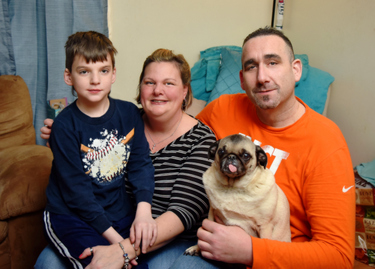
“It’s truly a blessing to know that there are people there to support you and to help him as far as his school and learning and life skills,” says Maxine. “It was Jennie who taught him to tie his shoes because, being visually impaired, there are different things you need to learn.”
Education services for blind and visually impaired children have been offered by Catholic Charities since 1974, when Catholic Charities was still known as the Diocesan Bureau of Human Relations Services. Jennie is one of 17 teachers for students with visual impairments. Each school year, the TVI’s work with approximately 300 students from Fort Kent to Kittery.
The program is funded through the Maine Department of Labor’s Division for the Blind and Visually Impaired and through your gifts to the annual Catholic Appeal. As state funding becomes scarcer, the money from the appeal is more important than ever. It is used to purchase technology, to train TVI’s, and for any new programs that are developed to help students.
Jennie works with 18 students, who range in age from newborn to 21.
“We go to preschools, daycares. We go to grandma’s house, if the child is at Grandma’s, and then we go all the way through until they graduate from high school or they graduate from whatever program they’re in. It may be a functional life skills program, and they can stay there until 21.”
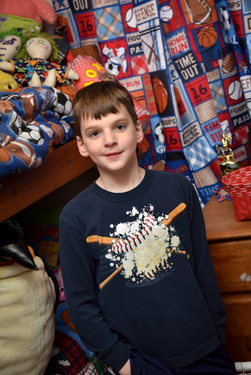
“It’s everything from highly cognitive, very high functioning with low vision, all the way up to multiply impaired, not speaking, not walking,” says Jennie. “I have a deaf-blind kiddo who takes in information by licking. So, on his learning media, it has to be things that he can explore orally. You can’t give him something that he is not to put in his mouth because he has no hearing, and he has no sight, so that is how he is going to learn.”
When working with infants, the services are mostly consultative, helping parents understand how to best help their child. For instance, if their baby has limited vision, parents need to be sure their interactions take place near the child and not from across the room.
“If it is a multiply impaired child, we would say use any tactile experience. If you have a chance to give that child the most tactile experience, you wouldn’t change her on a changing table, you would change her on your lap so that she could feel you shifting your weight in your legs,” says Jennie. “Your legs are warm. She can smell you.”
In Derek’s case, Jennie spends about four hours a week teaching him Braille and helping him with social skills, as well as working with his teacher, an Ed Tech, and his classmates.
“I’ve been in the classroom and done some inclusion activities, so the kids know what he’s learning. There is a huge chart on the wall that I made, and the kids followed the alphabet as he learned every letter,” Jennie says. “He learned the letters individually, the Braille alphabet, so every time he mastered a letter, he got a SpongeBob sticker over the top of the letter so they could count how many he learned. And they knew, ‘Oh, he learned a letter in my name.’”
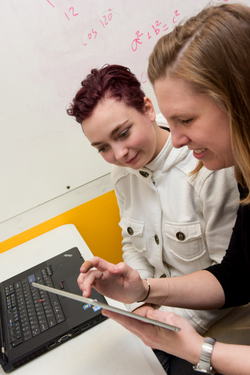
“It’s been an interest of mine since I was little,” she explains. “My whole family, we’re Italian, and we like to cook a lot.”
Hailey was born with optic nerve hypoplasia (ONH).
“The condition affects my optic nerve and how I display images, and the definition and the quality of images,” she explains.
Hailey is a visual learner, but it has to be large print and the right lighting conditions.
“I can go plus, plus, plus, plus, plus, plus,” she says, hitting the key on her laptop. “I learn to have the light behind me. That way it’s not in front of me, and I have a clearer picture of what’s going on. And I tend to not go somewhere that’s too dark but also isn’t too light. It has to be a good medium.”
Hailey and Jennie have worked together since Hailey was in the fourth grade, but the type of assistance has evolved through the years. At first, it was providing her with materials and guiding her through their use.
“When I was younger, it was more like, ‘Let’s help Hailey figure out what she needs. Let’s help her get what she needs,’ and she was more like a voice for me,” explains Hailey. “When it became middle school, it was, ‘Let’s help Hailey advocate for herself.’ And now, it’s like, ‘Let’s help Hailey grow and be able to accomplish the things she wants to do.’”
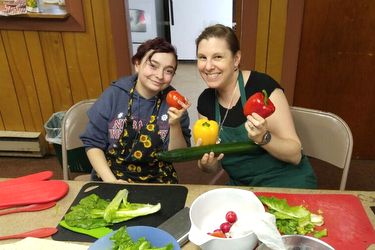
“Recently, it’s been how are we going to interact with people who we’re only going to have a few minutes in life with, someone at the fast food counter who doesn’t need to know our whole deal and hasn’t earned our trust,” explains Jennie.
“When it comes to people that I’m never going to socialize with or have a bond with, it’s very hard for me because I get nervous,” says Hailey.
E.S.B.V.I.C. regularly offers field trips to help the students with those interactions. The children and teens have gone to the fire station to learn CPR. They have volunteered at Wayside Food Programs in Portland, and they have gone on mall scavenger hunts, which is one of Hailey’s favorite excursions.
“We have to find things, but we actually have to ask people around us. ‘Where is this? How can I get this?’” says Hailey.
“It’s our sneaky way of getting social skills packed in because a lot of it is information gathering and a lot of it is interacting, even with your peers,” says Jennie.
“I like going on field trips mostly because I get to meet other people like me and have a shared experience,” says Hailey. “We’re like one big community.”
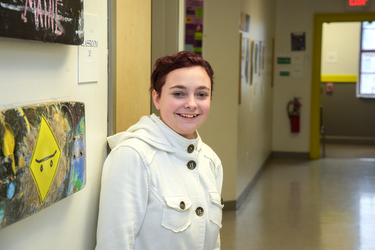
“This program is amazing. It helps a wide variety of people. From my experience, it really helped me grow as a person, and it really helped me figure out what I want to do and how I’m going to do it; that I, as a visually impaired person, don’t have to have these limits that would be what people would think of someone who has a vision impairment.”
Derek’s parents feel just as strongly, saying that Jennie and the program have meant the world to them and their son.
“I don’t know where we would be without it,” says John. “Derek is very reserved and quiet until you get to know him, but he opened right up with her.”
“She makes it comforting, and she doesn’t put a lot of pressure on me when I read and stuff,” says Derek.
“She makes it fun for him, too, so it’s something he enjoys doing,” says Maxine.
“She knows he loves sports, so she made this hockey game, like a tactile game,” says John. “She made it really detailed for him.”

“She is so outgoing, and she is nurturing, too, with him, but she pushes him when she has to,” says John. “We’ve been approached by a couple people at school wondering if he is being pushed too much, but we’re happy.”
“I think Jennie has gotten to know him so much that she knows when he is actually trying and when he is slacking off,” continues Maxine. “We’re very happy.”
Although it is not the case with all the TVI’s, Jennie has a visual impairment herself. She says it gives her an understanding of what the children are experiencing.
“I think that enriches what I do. I can come to the table with an empathy for the kids,” she says. “The constant that we’re always reaching for is more and more independence for that student.”
John and Maxine say that Jennie has given them confidence that Derek’s limited vision won’t hold him back.
“Catholic Charities is paving the road for him,” says Maxine. “She is an inspiration.”
“Bigtime,” adds John. “We see the way Jennie is, and it gives us so much hope that Derek is going to be fine when he gets older.”
“I know she gives me a lot of hope,” adds Maxine.
And for Jennie, what better reward could there be?
“Isn’t it cool?” Jennie asks. “I have the best job! I love what I do!”










